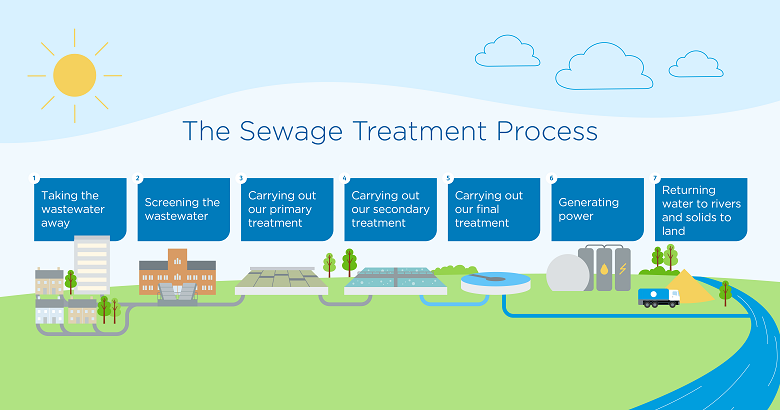Strategic Approaches to Boost Waste Water Treatment Performance and Minimize Ecological Influence
In the realm of waste water therapy, the mission for improved performance and minimized environmental effect is a perpetual challenge that demands critical services. The assimilation of innovative treatment technologies, energy-efficient procedures, source recuperation strategies, improved nutrient removal strategies, and smart tracking and control systems stands for a diverse framework for resolving these pressing worries.
Advanced Treatment Technologies
Innovative membrane layer filtration systems have reinvented advanced wastewater therapy procedures, dramatically boosting the elimination of impurities. These ingenious systems work by requiring water with a semi-permeable membrane, successfully separating impurities from the water stream. The membrane layer's tiny pores trap contaminants such as microorganisms, viruses, and suspended solids, allowing only cleansed water to pass through. This modern technology has actually confirmed to be highly reliable in getting rid of a large range of pollutants, consisting of pharmaceuticals, heavy steels, and natural substances, which are frequently testing to remove with typical treatment methods.
Furthermore, membrane filtration systems use countless benefits over traditional treatment approaches. They call for much less room, produce higher-quality effluent, and are extra resistant to variations in influent water quality. In addition, these systems are highly functional and can be easily integrated into existing treatment plants or used as standalone systems for decentralized applications. As the need for tidy water continues to rise, the fostering of sophisticated membrane layer filtering technologies is vital to guarantee effective and lasting wastewater therapy techniques.
Energy-Efficient Processes
The assimilation of energy-efficient processes in wastewater therapy systems is critical for optimizing source usage and decreasing functional expenses. By applying energy-efficient technologies, therapy plants can dramatically lower their carbon impact and total environmental effect. One key approach to improving energy performance in wastewater therapy is the usage of sophisticated oygenation systems, such as fine bubble diffusers or surface area aerators, which can improve oxygen transfer effectiveness and reduce power consumption. Additionally, integrating energy healing systems, like anaerobic digestion for biogas production or using excess warm for thermal procedures, can help counter energy demands and advertise sustainability.
In addition, optimizing procedure control and automation with making use of innovative sensing units and keeping an eye on systems can enhance overall energy efficiency by adjusting operations in real-time based upon actual need and conditions. Applying power audits and consistently keeping an eye on energy performance indicators are essential practices to determine areas for enhancement and track energy-saving campaigns effectively. Generally, the fostering of energy-efficient procedures in wastewater therapy not only profits the environment but likewise adds to lasting cost financial savings and functional sustainability.
Source Recovery Techniques
With an emphasis on optimizing source use and sustainability in wastewater therapy systems, the application of resource recovery approaches becomes an essential facet in enhancing functional efficiency. Source recovery methods in wastewater therapy include the identification and extraction of important resources from the waste stream, thereby transforming what was once thought about waste right into a useful asset. By applying resource recuperation strategies such as nutrient removal and healing, power generation from organic matter, and the production of recyclable water, wastewater therapy plants can reduce ecological influence while making the most of efficiency.

Boosted Nutrient Removal Techniques
Carrying out advanced nutrient removal strategies is essential for optimizing the efficiency of wastewater treatment systems. Enhanced nutrient elimination plays a critical function in reducing the ecological influence of treated effluent released into water bodies. One of the essential methods utilized for improved news nutrient elimination is the procedure of biological nutrient removal (BNR), which entails the removal of nitrogen and phosphorus with biological procedures. This can be attained through the usage of specialized bacteria that can transform nitrogen substances into inert nitrogen gas through denitrification, and build up phosphorus within their cells via a procedure called improved biological phosphorus elimination (EBPR)

In enhancement to BNR, progressed therapy techniques such as membrane layer bioreactors (MBRs) and constructed marshes can also be used to improve nutrient removal performance. MBRs utilize membranes to attain premium effluent criteria by efficiently eliminating nutrients and suspended solids. Constructed wetlands imitate natural wetland processes to remove nutrients via plant uptake, microbial task, and sedimentation. By integrating these innovative nutrient elimination methods right into wastewater treatment towns, systems and sectors can effectively reduce nutrient pollution and protect the environment.
Smart Tracking and Control Systems
Making use of cutting-edge modern technology, the integration of wise monitoring and control systems changes the operational efficiency of wastewater therapy centers. These systems integrate sophisticated sensors and information analytics to constantly keep track of crucial specifications such as pH levels, turbidity, liquified oxygen, and flow prices in real-time. By collecting and assessing this information, drivers can gain valuable insights right into the performance of the therapy processes, making it possible for positive changes to enhance therapy performance.
Smart monitoring and control systems also sustain remote monitoring abilities, allowing drivers to access real-time data and control features from off-site locations. This remote access boosts functional versatility and responsiveness, making it possible for swift treatments in case of system malfunctions or variations in influent quality. In addition, the predictive maintenance capacities of these systems help protect against equipment failures and decrease downtime, ultimately improving the general reliability of wastewater treatment procedures (Waste Water Treatment).
Conclusion
Finally, critical strategies such as innovative treatment technologies, energy-efficient processes, resource healing methods, boosted nutrient elimination techniques, and smart monitoring and control systems play a vital duty in boosting wastewater therapy efficiency and reducing environmental effect. By carrying out these methods, wastewater treatment plants can boost their overall efficiency, minimize power usage, recuperate valuable resources, and make certain conformity with ecological guidelines. These go now techniques are important for efficient and sustainable wastewater monitoring techniques.
In conclusion, calculated approaches such as sophisticated treatment modern technologies, energy-efficient processes, resource recuperation techniques, boosted nutrient removal strategies, and wise surveillance and control systems play an important duty in enhancing wastewater therapy effectiveness and reducing ecological influence.
Comments on “Cutting-edge Approaches to Waste Water Treatment Technologies”